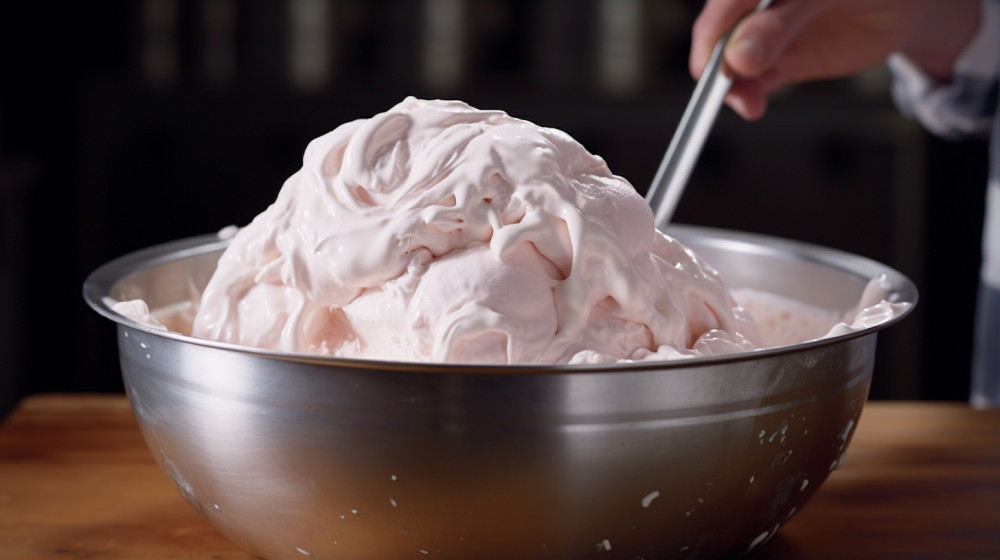
Welcome back to ScoopGurus for another walk-through! This time we are going to be working on a particular skill set, how to master the art of “churning” ice cream. Imagine boasting with your OWN creation of a velvety, creamy, and delectable dessert. You can. But first, we need to overcome one of the major challenges in your ice cream’s odyssey (and what I view as one of the most critical) – the churning process.
Churning, isn’t just a step in the process. It’s both an art form to master and a science to befriend. It’s the heart of ice cream making, and understanding it isn’t just an option; it’s crucial. It’s like knowing your dance partner’s moves before you glide onto the dance floor. Without it, you’d be tripping more than twisting.
When you learn the proper ice cream churning technique, it’s a GAME-CHANGER. You gift yourself the power to create any ice cream, from a traditional vanilla bean dream to the wildest flavor you can conceive. (Bacon Ice Cream? Bring it on!).
So let’s dig deeper, embark on a grand ice creamy adventure, and decode the secrets of churning…Ready for the next step? Let’s break down the process and get into the nitty-gritty of how to churn ice cream properly.
Break Down the Ice Cream Churning Process
Now that we’ve got the basics covered, it’s time to dive deeper into the heart of ice cream making – the CHURNING process. This is the step where MAGIC happens. The liquid base gradually transforms into a fluffy, frozen treat that we all know and love.
See, churning is not just a fancy word – it’s a SCIENCE. It serves to cool the ice cream mixture while simultaneously whipping it to incorporate air. This combo of cooling and airstream is what gives ice cream its hallmark creamy, smooth texture.
So, how does it happen? Well, let’s break it down…
1. PREPARE YOUR MIX: Start with your favorite ice cream base (vanilla, chocolate, strawberry, you name it), and ensure it’s well-chilled, ideally leaving it to cool in the fridge overnight.
2. SET UP YOUR ICE CREAM MAKER: Following your machine’s instructions, ensure it’s clean, assembled correctly, and frozen as necessary.
3. POUR IN THE MIX: With the ice cream maker churning, gradually pour in your chilled ice cream base. Too fast, and you’ll lower the temperature dramatically, affecting the freezing process.
4. CHURN AWAY: Now, patience is KEY. Allow the mix to churn till it reaches a soft-serve ice cream consistency. Depending on your machine, this could be anywhere from 15 minutes to 1 hour.
5. FREEZE TO HARDEN: Once churned, transfer your ice cream into a lidded container and freeze. Give it several hours, or better yet, overnight for the best texture and flavor.
The extraction of timing and temperature from this list should stand out. They’re vital cogs in the ice cream churning machinery, if you will… but more on that in the next section!
Common Mistakes and How to Avoid Them
Since we’ve wandered through the basics of ice cream churning, YOU might think you’re well on your way to becoming the next Ben or Jerry…but hold on! Before pouring all your energy into your new foodie venture, I need to make it crystal clear that mistakes do occur in this creamy journey, and it’s crucial to quickly recognise and nip them in the bud.
Mistake #1: Too Much Sugar
One of the biggest troublemakers is adding too much sugar. Sure, a little extra sweetness might sound tempting, but having a heavy hand with the sugar can hinder the freezing process, leading to an unpleasantly soft texture. The solution? Stick to the recipe…then once you’re comfortable, feel free to experiment in MODERATION!
Mistake #2: Temperature is Too Warm
Temperature plays a vital role too. An error I’ve seen countless ice cream society newbies make is not cooling their ice cream base sufficiently before churning. If the base is too warm, it can make the ice cream grainy instead of smooth. Always make sure to adequately chill your base, ideally overnight in the fridge, prior to churning.
Mistake #3: Churning the Ice Cream Too Long
Lastly, let’s bust a myth: churning ice cream longer will make it creamier – FALSE. Over-churning leads to over-aerated ice cream, which is a fancy term for ‘fluffy’, ‘icy’ and ‘not what you’re aiming for’. Trust in the process, your machine, and, of course, your instinct! Respect your churn time…neither too short nor too long.
Avoiding these pitfalls will set you on a clear path towards indulgent ice cream delights. Once you’ve mastered these, you’re ready for the next stage – flexing your creative muscles and becoming a true ice cream artisan…
Master Your Ice Cream Churning Skills
After learning all there is to know about the churning process, it’s time for the fun part — experimenting with various flavours and ingredients. Ice cream isn’t just about vanilla or chocolate anymore… Think sorbets, gelatos, or even alcohol-infused delicacies. The world of flavors is vast and unexplored!
Remember that different ingredients have their own unique properties. They can alter the texture and creaminess of your ice cream depending on how they are incorporated during the churning process. For instance, adding too much sugar or certain types of alcohol can lower the freezing point of your mixture, and this, in turn, can affect the churning process. On the flip side, fruits, nuts, chocolates or cookie chunks can add that extra oomph! Just note these components are usually added after the churning process to prevent them from interrupting the formation of the micro ice crystals.
Finally, let’s talk about my favorite part – adaptation. Once you master the basics, you become the conductor of your own symphony. You don’t need to follow someone else’s recipe to the dot. Trust your palate, trust your instinct, and don’t be scared to take some risks. Try different combinations, play around with textures, consider savory elements – it’s your playground, so just let loose!
Making ice cream is much more than just following a recipe. It’s about creating an experience, a memory. Every time you churn your ice cream, you’re crafting a small piece of joy. So, enjoy the process, have fun, and master the art of ice cream churning! Here’s to creating many more flavorful memories.

I agree with you that making ice cream is not about the recipe but mastering the skill. Unfortunately a lot of us rush to the recipes with understanding each ingredient in details. I started making my own ice cream some months ago. But I know I need to master the act. Please can you recommend a course or book that is detailed on making ice creams.
Yeah, very much like baking we all have the proper set of ingredients, it comes down to the “art” of putting these ingredients together to create a beautiful end product. In the ice cream world, one of these key stages of the making process is the churning and if this is down correctly, your ice cream will turn out amazing. If not, then it can turn out less than desirable.
As for great books for learning this, one I recommend is called “The Perfect Scoop“. This is written by David Lebovitz, and is an excellent read if you want to master the art of creating an awesome ice cream…and of course don’t hold back when viewing other content here on my website. You are going to be getting a lot of great information about ice cream making.
Hey thank you for this website!
I adore sweet desserts especially ice cream, I enjoy them in the summer and even winter too! There are just so many flavour to try out , endless opportunities.
I am going to save this page and use it next time I would like to enjoy a scrumptious treat!
Have a great day!
There are definitely lots of flavors to try out, and you can get very creative with your infusions as you do start do build out your different flavor profiles.
The key though to a quality (better than store bought) ice cream, is understanding how to properly churn it. This will lead to it having that pure, rich and smooth texture that we are all after when making our own ice cream.